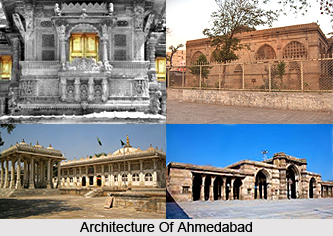Ahmedabad is the largest city in the state of Gujarat in West India. The city developed as a Muslim city because it was under the dominion of many Muslim powers. Thus the Islamic architectural style is the most prominent form of architecture in Ahmedabad. A blend of Indo Islamic style is also seen in some of the buildings and monuments. Apart from Islamic architecture there are also few specimens of Jain and Hindu architecture in the city of Ahmedabad. Buildings which have been constructed in the Post independence era are noteworthy architecture of this place.
This city of Ahmedabad was built in the year 1411 AD by Sultan Ahmed Shah and was ruled by the Ahmed Shahi dynasty during 15th-16th century and hence developed as a Muslim city. It served as the capital of the Gujarat sultanate. Ahmedabad was under Mughal control until 1578. Under the British rule a military cantonment was set up in this city and its infrastructure was modernised. Located on the bank of the Sabarmati River, Ahmedabad is noted for its rich collection of Islamic architecture.
 Several Islamic architectures developed under the reign of Sultan Ahmed Shah, the founder of Ahmedabad. The Hindu and Jain temples were destroyed and the materials were used to construct mosques. The facade of the Ahmed Shah`s mosque has a large arch with two minarets on either side of the arch, thus paving the way for an innovative style of mosques, called the Gujarati style. Bibi ki Masjid is another example of mosque built by Ahmed Shah. The biggest mosque of Ahmedabad is the Jami Masjid Friday mosque the courtyard of which is surrounded by an enclosing corridor and enables the faithful to assemble for Friday prayers. In the centre of the facade is the three-arch entrance. It was built by traditional Indian craftsmen and architects. Having a row of pillars in the hall within the mosque, is Arabic in style. This monument of Ahmedabad displays a blend of Islamic and Indian architecture. The mausoleums like the tomb of Rani Sabrai is crowned with domes and Islamic parapets, pillar and beam structures, stone eaves, stone ceilings on the walls and filled with traditional craft.
Several Islamic architectures developed under the reign of Sultan Ahmed Shah, the founder of Ahmedabad. The Hindu and Jain temples were destroyed and the materials were used to construct mosques. The facade of the Ahmed Shah`s mosque has a large arch with two minarets on either side of the arch, thus paving the way for an innovative style of mosques, called the Gujarati style. Bibi ki Masjid is another example of mosque built by Ahmed Shah. The biggest mosque of Ahmedabad is the Jami Masjid Friday mosque the courtyard of which is surrounded by an enclosing corridor and enables the faithful to assemble for Friday prayers. In the centre of the facade is the three-arch entrance. It was built by traditional Indian craftsmen and architects. Having a row of pillars in the hall within the mosque, is Arabic in style. This monument of Ahmedabad displays a blend of Islamic and Indian architecture. The mausoleums like the tomb of Rani Sabrai is crowned with domes and Islamic parapets, pillar and beam structures, stone eaves, stone ceilings on the walls and filled with traditional craft.
The Havelis of Ahmedabad display the exquisite architecture of Gujarat. Detailed carving tech-niques have been perfected in the wooden architecture of Gujarat. These wood houses are still found in the old residential areas of Ahmedabad. The brackets, window frames, pillars, etc. that face the road are exquisitely carved. Post independent architectural style constitutes a major portion of architecture in Ahmedabad. For example the Mill Owner`s Association Building was designed by a British architect and has a concrete framework on both sides of the three storeyed domino box like building has brought in a lot of shade. This carved and sculpted kind of moulding goes well with traditional Indian architecture. The building of Indian Institute of Management in Ahmedabad has an architectural pattern with geometrical shapes blend-ed well with traditional Islamic architec-ture. The Gandhi Labour Institute built in 1984 resembles the architecture of Rajput palaces.
Ahmedabad is, thus, a storehouse of Islamic architecture. The exquisite structural design of the mosques and mausoleums enhances the architectural beauty of the city.